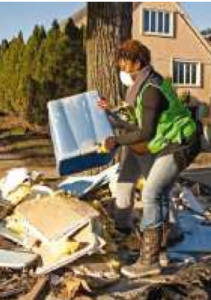 Protecting a home from hurricane damage is a priority for every coastal resident. Using the right building products and taking advice from industry experts can help secure a home from even the fiercest storms.
Protecting a home from hurricane damage is a priority for every coastal resident. Using the right building products and taking advice from industry experts can help secure a home from even the fiercest storms.
Find out What your home’s worst enemy is during a hurricane. Not the driving rain. Not the frequent lightning.
What is your home’s worst enemy during a hurricane? Not the driving rain. Not the frequent lightning. Your home’s worst enemy is the one-two punch of intense winds and flooding that accompany a severe storm.
During a hurricane, winds reaching up to 150 mph or more can put horizontal pressure on your home. As the wind flows over the roof, it creates a strong lifting effect much like air flowing over the wing of an airplane. With that pressure, roof shingles and sheathing can be effortlessly torn off your home, allowing rain and more wind pressure inside the home. Simultaneously with the wind, the storm surge can race toward your home, uprooting trees and causing catastrophic damage.
Those same devastating winds can make a second strike at your home when they lift anything from yard furniture to tree limbs and turn them into missiles targeted at your home. When these flying objects strike a window or door during a hurricane, they can do catastrophic damage to a home, opening it up to allow powerful air and force to enter the home causing damage to the structure and interior.
Storm surges can devastate a house with fast-moving waters that can actually pull a home apart and off its foundation. Once water enters a house, the infrastructure of your home is seriously affected, even after the waters have receded.
“A home is usually a person’s single largest financial investment, so if you live in a coastal area it makes sense to protect your home with hurricane-resistant products and smart building practices,” according to Don Zeman, host of the nationally syndicated Homefront home improvement radio show and television news segments. “Purchasing products that are made to help you weather a storm safely can give you peace-of-mind throughout the entire year. Many of these same products also help you gain significant reductions on homeowner insurance.”
Zeman, who was a contractor and builder for 25 years before starting his radio show and television tips series, recommends that coastal homeowners make their homes more secure both at the time of initial construction and during remodeling or rebuilding. “New products are constantly being introduced and tested that can truly help protect a house and its contents from severe weather damage,” says Zeman. “The key areas to safeguard are the roof, entryway, garage door and windows. If one of these four areas is compromised, then wind pressure can enter the home with enough force to literally blow the roof off.”
If you live in an area subject to severe weather, consider the following ways Zeman and his research team recommend protecting your home from hurricane damage:
Project #1 – During construction of your home, make certain your builder uses steel connectors or metal straps that fasten within the frame of the home to help strengthen joints. Much stronger than nails, connectors and tie-downs attach to the roof, foundation and wall framing to help secure the skeleton of your home. This helps your home resist extreme wind forces during a hurricane and keeps the roof attached to the home.
Project #2 – Looking for peace-of-mind and power when hurricanes threaten? Then consider investing in a permanently installed standby automatic generator. Natural gas and LP generators by Kohler Power Systems are installed outside the home, much like an air-conditioner system. If electrical power fails, a transfer switch automatically starts the power system and restores electricity to your home – even if you’re not there. Homeowners can decide if they want just their essentials to be backed up by the generator (such as lights, refrigerator, sump pump and air conditioner) or if they want the entire house to have restored power.
Project #3 – Make certain to invest in roofing shingles that have strong impact and wind resistant ratings. Go for the highest ratings possible and you may get a discount on your homeowners insurance. Also, investigate interlocking roof shingles that have mechanisms that help shingles lock together to help prevent the shingles from being torn off the roof during high winds.
Project #4 – Don’t struggle with the time- and labor-consuming effort of shuttering up your windows before a hurricane. Impact-resistant Simonton StormBreaker Plus windows and patio doors are ready for severe weather 24 hours a day, seven days a week. A heavy invisible plastic interlayer sandwiched between panes of glass prevents the puncturing of the windows from flying debris. The same hurricane-resistant glass protects the home year-round from break-in attempts, solar and noise penetration. Energy efficient and easy to maintain, the vinyl-framed windows and doors act much like your car windshield – when impacted, the glass may shatter, but it will not break out of its frame so your home and its contents are protected.
Project #5 – When your community is under a hurricane watch, store away all loose outside items, such as garbage cans, lawn furniture and potted plants. Remember to anchor down and reinforce lightweight yard structures, such as storage sheds, swing sets and barbeque grills. These items can all become flying projectiles during hurricane strength winds that can cause massive damage to your home or other houses in your neighborhood. If enough notice is given you can take all your loose outside items to your self storage unit such as 231 Self Storage for protection to the items, your house and your family.
Project #6 – If you live in an area that is repeatedly threatened by hurricanes, you may want to invest in a “safe room” in your home. Anchored to a concrete foundation, a safe room consists of reinforced wall panels that form a protective barrier from airborne objects during a hurricane. You can store valuables in this specially-constructed storm shelter or ride out the worst of severe weather inside the room.
Project #7 – When severe weather threatens, forget about boarding up with heavy steel or plywood panels. Lightweight Fabric Shield Storm Panels by Wayne-Dalton are PVC coated woven fabric panels that weigh only four ounces per square foot. Fast and easy to install, the impact-resistant panels can help protect entry doors and windows from being destroyed by flying debris. The translucent panels allow light to enter the home and comply with all major building codes. After the storm, simply remove the fabric panels and store them rolled up, laid flat or hung in a dry area.
Project #8 – Select a front entry door that won’t “blow in” during high winds. Look for a door with the highest Design Pressure Rating (DP) possible. This rating will tell you how much wind force your entry door can withstand without falling, leaking or cracking. Some entry doors have a DP100 rating, meaning they can hold up against 100 pounds of force per square foot. This translates into the static pressure generated by winds up to 250 mph.
Project #9 – Think carefully about the framing wood used when constructing or remodeling your coastal home. Treated Southern Pine includes a safe preservative that helps prevent the onset of decay following a period of intense wetness, such as you’d experience during floods after a hurricane. The preservative used to treat the lumber also prevents insect infestations, so it’s ideal for use as decks, patios and boardwalks. Strong and durable, Southern Pine is highly resistant to wear and tear.
To learn more about hurricanes and ways to protect your home, visit the Web sites for the Federal Alliance of Safe Homes (FLASH) at www.flash.org or the Institute for Business and Home Safety at www.ibhs.org.
This article is sponsored by D & S Home Improvements in St. Mary’s County, MD






